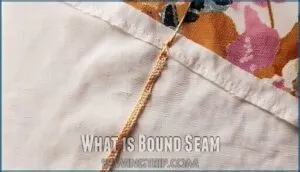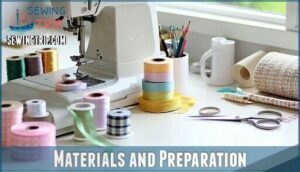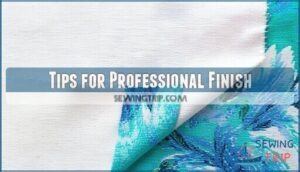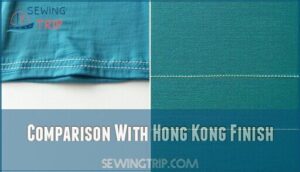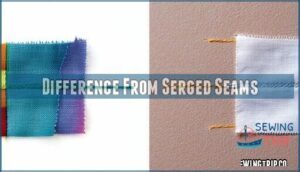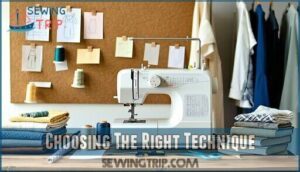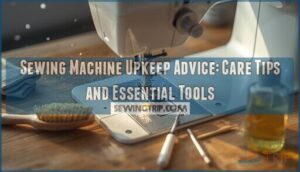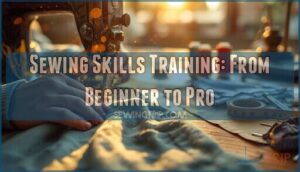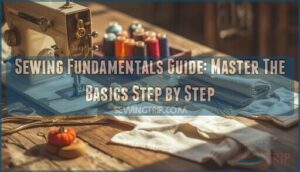This site is supported by our readers. We may earn a commission, at no cost to you, if you purchase through links.
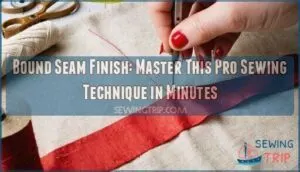
You’ll transform rough, unfinished edges into professional-looking details that protect your fabric from unraveling while adding visual appeal to garment interiors.
This technique works perfectly for unlined jackets, children’s clothing, and curved seams where both sides of the fabric show.
Simply encase the raw edge with bias binding and stitch it down—no fancy equipment needed.
It’s like giving your seams a custom jacket, turning amateur-looking edges into couture-quality finishes.
The secret lies in choosing the right binding material and mastering a few essential techniques.
Table Of Contents
Key Takeaways
- You’ll encase raw fabric edges with bias tape or fabric strips to prevent fraying and create professional-looking seams that won’t unravel over time.
- This technique works perfectly for unlined garments, curved seams, and children’s clothing where both sides of the fabric are visible and need a polished finish.
- You don’t need fancy equipment – just bias binding, sharp scissors, and your sewing machine to transform amateur-looking edges into couture-quality details.
- Choose lightweight binding materials like cotton or silk to avoid adding bulk, and always test on fabric scraps first to ensure the best results for your specific project.
Bound Seam Finishes
You’ll transform raw seam edges into polished, professional finishes using bias binding strips that prevent fraying and add decorative flair.
Elevate every seam from amateur to artisan with professional bias binding techniques
This technique encases rough edges completely, making your garment’s interior as neat as its exterior while eliminating the bulk of traditional seam finishes, which helps to achieve a professional look.
Definition and Purpose
A bound seam finish transforms raw fabric edges into polished, professional-looking seams by encasing them with bias binding or fabric strips.
Transform ordinary seam edges into professional-grade finishes that rival expensive couture craftsmanship.
This seam finishing technique prevents fraying while adding aesthetic appeal to your garments’ interior.
- Edge Protection: Shields cut fabric edges from unraveling and wear
- Aesthetic Appeal: Creates clean, finished seams visible inside unlined garments
- Durability Focus: Extends garment lifespan by reinforcing seam allowances
- Professional Finish: Elevates homemade pieces to couture-quality standards
Benefits for Garments
You’ll discover that bound seam finish techniques offer remarkable durability enhancement, preventing fraying while adding aesthetic appeal to unlined garments.
This cost-effective method creates a professional look without expensive full linings, making it perfect for versatile application across jackets, skirts, and accessories.
One can also use Hong Kong seams for a couture finish. Your fabric edge finishing becomes both functional and stylish.
Suitable Fabrics and Projects
You’ll find bias bound seam works best with lightweight fabrics like cotton, silk, or rayon that won’t add bulk.
Choose lightweight fabrics to avoid bulk and achieve professional seam finishes
This technique shines on curved seams in unlined jackets, childrens clothing, and bag linings where fabric thickness matters.
Perfect for skirts and unlined garments where both sides show, making it ideal for unlined garments.
What is Bound Seam
A bound seam finish wraps fabric strips around raw edges, creating a clean, professional look that prevents fraying.
This seam anatomy technique encases your seam allowances completely, like wrapping a present. Unlike serged edges, bound seam finish adds decorative potential through contrasting colors or patterns.
The bias tape finish method uses bias binding cut at 45-degree angles, allowing flexibility around curves. Seam variations include single-fold and double-fold approaches, while seam innovations have made this binding tutorial accessible to home sewers without specialized equipment.
For lightweight fabrics, consider Hong Kong seams for a couture finish.
Bias Bound Seam Techniques
You’ll master bias binding techniques that transform raw, fraying edges into professionally finished seams that rival expensive tailoring.
This method works perfectly for unlined jackets, curved armholes, and any project where you want both sides of your garment to look polished and intentional.
Materials and Preparation
Getting your materials right sets you up for success. You’ll need bias tape—either store-bought or homemade binding works perfectly.
For binding width, choose single-fold or double-fold bias tape based on your fabric weight. Lightweight cotton or silk creates the best homemade binding without bulk.
To finish the edges, consider a Hong Kong finish for a professional touch. Essential tool selection includes sharp scissors, pins, and your trusty bias tape maker for consistent results with the right bias tape.
Sewing Steps and Methods
Now you’ll execute the actual sewing process. Start by sewing your main seam with a ⅜-inch to ⅝-inch seam allowance, then press it open.
Position your bias binding along each raw edge, aligning carefully for binding attachment. Fold the binding over completely, encasing the raw edges using proper folding techniques. Secure everything with topstitching methods, stitching close to the folded edge.
For various colors and materials, explore options for purchasing binding tape. Finish by pressing seams flat for crisp results.
- Feel the satisfaction as your raw edges disappear under smooth, professional binding
- Watch your garment transform from homemade to couture-quality with each precise stitch
- Experience the pride of creating seam finishing techniques that rival expensive ready-to-wear clothing
Tips for Professional Finish
Master professional finish by maintaining consistent width throughout your bias bound seam.
Choose lightweight binding that won’t add bulk, and press each step thoroughly for crisp edges.
Use precise stitching when topstitching – keep your needle steady for clean lines.
Pay attention to corner detailing where seams meet, trimming excess binding to prevent puckering.
Your seam allowance determines binding success.
Seam Finishing Methods
You’ll find several seam finishing methods to choose from, each with distinct advantages for different projects.
Understanding when to use bound seams versus Hong Kong finishes or serged edges will help you select the perfect technique for your fabric and garment style, using the best seam finishing methods.
Comparison With Hong Kong Finish
Hong Kong finish and bound seam finish differ in stitching visibility and edge neatness.
Hong Kong finish conceals topstitching in the seam ditch, while bound seam shows visible stitching lines.
Speed comparison favors Hong Kong—it’s faster with fewer folds.
Durability styles vary: bound seam encases all raw edges completely, Hong Kong leaves one binding edge raw inside.
Both appearance differences serve different garment needs effectively, adding elegance and durability to garments through techniques like the elegance and durability.
Difference From Serged Seams
You’ll notice clear differences between bound seam finish and serged edges when comparing seam finishing methods.
Serged seams prioritize serger speed over seam strength, while bound seams offer superior fabric compatibility and edge neatness despite higher cost comparison.
Key differences include:
- Protection level – Bound seams fully encase raw edges, serged seams leave some exposure
- Durability factor – Bias bound seam resists fraying better than overlock stitching
- Bulk consideration – Serged finishes stay flatter, bound seam allowance adds slight thickness
Choosing The Right Technique
When choosing your seam finish technique, consider fabric thickness first—lightweight materials work best with bias bound seams, while heavier fabrics might need serging.
Your project type matters too: unlined jackets benefit from bound seams, but casual wear mightn’t need this level of detail.
Match your skill level with the technique’s complexity, and remember that seam visibility affects your aesthetic preference.
For swimwear, consider that zigzag stitching prevents fraying.
Bound seam tutorials help beginners master these professional seam finishing methods.
Bound Seam Applications
You’ll find bound seam finishes work perfectly for unlined jackets, coats, and custom garments where the inside needs to look as polished as the outside.
This technique shines on curved seams like armholes and necklines, plus it’s your go-to solution when working with loosely woven fabrics that love to fray.
Garment Types and Styles
You’ll find bias bound seam techniques perfect for unlined jackets, where the interior needs polished finishing.
Skirt seam finishes benefit from this method, especially in A-line styles with curved seams.
Childrenswear applications shine here—growing kids need durable, comfortable seams that won’t irritate skin.
Couture garment details often feature bound seams for that luxury touch, while historical garments traditionally used these garment construction techniques before modern sergers existed.
Fabric Selection and Considerations
Thin, lightweight fabrics like china silk or cotton batiste work best for binding fabric since they won’t add bulk to your seam allowance.
Match your binding fabric weight to your main fabric – heavy fabrics need wider bias tape, while delicate ones require narrower strips.
Test different fabric properties on scraps first, paying attention to how the fabric grain affects drape around fabric edges.
When considering fabric, remember that cotton offers breathability, making it a comfortable choice for projects that require delicate handling and breathability.
Aesthetic and Practical Uses
Because bound seams deliver both form and function, you’ll discover they’re perfect for elevating your sewing projects.
This bias bound seam technique transforms ordinary seam allowances into design features while providing exceptional durability enhancement.
- Color Accents – Add vibrant binding to create striking visual contrast against your main fabric
- Pattern Matching – Use coordinating prints for a cohesive, professional appeal throughout your garment
- Cost Effectiveness – Skip expensive linings while achieving that neat seam finish look
- Aesthetic Finish – Turn functional seam work into decorative elements that impress
Frequently Asked Questions (FAQs)
What is a bound seam finish?
Like a protective shield wrapping around vulnerable edges, a bound seam finish encases raw fabric edges with bias tape or strips.
You’ll use this technique to prevent fraying while adding professional polish to unlined garments and curved seams.
What is a bias-bound seam finish?
A bias-bound seam finish encases raw fabric edges with diagonal-cut binding strips, preventing fraying while adding professional style.
You’ll wrap bias tape around seam allowances, creating durable, decorative finishes perfect for unlined garments and curved seams.
What is a bound seam?
A bound seam encases raw fabric edges with bias tape or binding strips, preventing fraying while adding a professional finish.
You’ll wrap the binding around seam allowances, then stitch it securely in place.
What is a seam finish in sewing?
Imagine neat, polished edges wrapping your fabric like a protective shield.
You’ll create seam finishes by treating raw edges to prevent fraying, unraveling, and wear, keeping your garments looking professional and lasting longer.
What is the difference between a bound and Hong Kong seam finish?
Hong Kong finishes hide topstitching by sewing from the seam ditch, while bound seams show visible stitching on the garment’s right side.
You’ll find Hong Kong finishes neater but slower to complete than bound seams.
What is bound seam finish?
A bound seam finish encases raw fabric edges with bias tape or binding strips, preventing fraying while adding decorative appeal.
You’ll stitch the binding around seam allowances for professional, durable results.
What are the three types of seam finishes?
Like threads weaving through fabric’s story, you’ll encounter three main seam finishes: serged edges that lock fibers tight, bias-bound seams wrapping raw edges like protective sleeves, and simple pinked cuts preventing fraying.
What are bound seam finishes?
You’ll protect fabric edges by wrapping them with bias-cut strips, preventing fraying while adding professional polish. This technique encases raw seam allowances completely, creating durable finishes perfect for unlined garments.
What is the difference between a bound seam and a serged seam?
Bound seams wrap fabric edges like a protective blanket, while serged seams cut and overlock edges in one step.
You’ll find bound seams offer decorative potential with bias tape, creating enclosed, bulkier finishes.
Serged seams provide quick, flat edge control.
What does "bound" mean in sewing?
In sewing, "bound" means you’re wrapping fabric strips around raw edges to encase them completely.
This technique prevents fraying, adds durability, and creates a clean, professional finish that’s visible from both sides.
Conclusion
Mastering what’s a bound seam finish is like becoming fluent in sewing’s universal language—it opens doors to countless professional possibilities.
You’ve learned the foundation technique that separates amateur projects from couture-quality work.
Practice these methods on fabric scraps first, then apply them confidently to your garments.
Remember, the right bias tape and consistent stitching create flawless results every time.
Your seams will thank you with years of durability and polish.
- https://peekaboopatternshop.com/our-blog/bias-bound-seam-finish-what-it-is-and-how-to-use-it
- https://inthefolds.com/q-a-series/2021/sewing-bias-bound-seams
- https://www.doinaalexei.com/applying-a-bias-bound-seam-finish.html
- https://www.asg.org/tailoring-tricks-hong-kong-seam/
- https://blog.closetcorepatterns.com/how-to-sew-hong-kong-and-bias-bound-seams/

